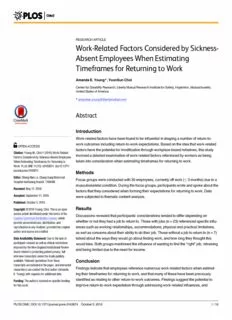Table Of ContentRESEARCHARTICLE
Work-Related Factors Considered by Sickness-
Absent Employees When Estimating
Timeframes for Returning to Work
AmandaE.Young*,YoonSunChoi
CenterforDisabilityResearch,LibertyMutualResearchInstituteforSafety,Hopkinton,Massachusetts,
UnitedStatesofAmerica
*[email protected]
a11111
Abstract
Introduction
Work-relatedfactorshavebeenfoundtobeinfluentialinshapinganumberofreturn-to-
workoutcomesincludingreturn-to-workexpectations.Basedontheideathatwork-related
OPENACCESS
factorshavethepotentialformodificationthroughworkplace-basedinitiatives,thisstudy
Citation:YoungAE,ChoiY(2016)Work-Related
involvedadetailedexaminationofwork-relatedfactorsreferencedbyworkersasbeing
FactorsConsideredbySickness-AbsentEmployees
WhenEstimatingTimeframesforReturningto takenintoconsiderationwhenestimatingtimeframesforreturningtowork.
Work.PLoSONE11(10):e0163674.doi:10.1371/
journal.pone.0163674
Methods
Editor:Sheng-NanLu,ChangGungMemorial
Focusgroupswereconductedwith30employees,currentlyoffwork((cid:20)3months)duetoa
HospitalKaohsiungBranch,TAIWAN
musculoskeletalcondition.Duringthefocusgroups,participantswroteandspokeaboutthe
Received:May11,2016
factorsthattheyconsideredwhenformingtheirexpectationsforreturningtowork.Data
Accepted:September11,2016 weresubjectedtothematiccontentanalysis.
Published:October5,2016
Results
Copyright:©2016Young,Choi.Thisisanopen
accessarticledistributedunderthetermsofthe
Discussionsrevealedthatparticipants’considerationstendedtodifferdependingon
CreativeCommonsAttributionLicense,which
whetherornottheyhadajobtoreturnto.Thosewithjobs(n=23)referencedspecificinflu-
permitsunrestricteduse,distribution,and
reproductioninanymedium,providedtheoriginal encessuchasworkingrelationships,accommodations,physicalandpracticallimitations,
authorandsourcearecredited. aswellasconcernsabouttheirabilitytodotheirjob.Thosewithoutajobtoreturnto(n=7)
DataAvailabilityStatement:Duetothelackof talkedaboutthewaystheywouldgoaboutfindingwork,andhowlongtheythoughtthis
participantconsentaswellasethicalrestrictions wouldtake.Bothgroupsmentionedtheinfluenceofwantingtofindthe“right”job,retraining
imposedbytheNewEnglandInstitutionalReview
andbeinglimitedduetotheneedforincome.
Boardrelatedtoprotectingpatientprivacy,full
interviewtranscriptscannotbemadepublicly
available.Relevantquotationsfromthese Conclusion
transcriptsareincludedinthepaper,andinterested
Findingsindicatethatemployeesreferencenumerouswork-relatedfactorswhenestimat-
researcherscancontactthefirstauthor(Amanda
E.Young)withrequestsforadditionaldata. ingtheirtimeframesforreturningtowork,andthatmanyofthesehavebeenpreviously
identifiedasrelatingtootherreturn-to-workoutcomes.Findingssuggestthepotentialto
Funding:Theauthorsreceivednospecificfunding
forthiswork. improvereturn-to-workexpectationthroughaddressingwork-relatedinfluences,and
PLOSONE|DOI:10.1371/journal.pone.0163674 October5,2016 1/16
Work-RelatedFactorsConsideredWhenEstimatingReturntoWork
CompetingInterests:Theauthorshavedeclared helpingpeopleworkthroughthetaskstheyneedtocompleteinordertomoveforwardin
thatnocompetinginterestsexist. thereturn-to-workprocess.
Introduction
Expectationshavebeenfoundtorelatetooutcomesinmanydomainsofhumanexistence.
Theyhavebeenfoundtohaveanimportantimpactondecision-makinginawidevarietyof
consumersettings[1].Theyareimportantpredictorsoftheoutcomeofanalgesictreatments
[2].Expectationshavebeenidentifiedasapredictorofoutcomeinnon-chronicnon-specific
lowbackpain[3].Andmorespecifictothecurrenttopic,workers’ownexpectationsfor
returningtoworkhavebeenfoundtobeoneofthebestpredictorsofactualreturntoworkout-
comes[4–7].Expectationsandinjuryperceptionsareincreasinglybeingexploredfortheirrela-
tionshiptoworkdisabilitybecauseoftheirroleininfluencingbehaviors[8].Althoughthereis
theunderstandingthatreturn-to-workexpectationsarerelatedtooutcomes,thereasonforthis
isstillunclear.Researchershavesuggestedthatindividualsassessamyriadofphysical,personal
andenvironmentalvariableswhenformingtheirreturn-to-workexpectations[9].Research
exploringhowpeopledeterminetheirrecoveryexpectationsidentifiedtheimportanceofself
(beliefs,attitudesandpastexperiences),pain(perceptions,asabarriertoactivityandattitude
towardspain),progression(improvementandgettingworse)andperformance(including
usualactivitiesofdailylivingandatwork)[3].However,therehadbeenlittleresearchthathad
soughttogainanunderstandingofthefactorspeoplereferencewhenaskedtomakepredic-
tionsabouttheirfuturereturntowork.
Basedontheideathat,ifwecanimprovetheunderstandingofreturn-to-workexpectation
formation,wewillbebetterplacedtodevelopwork-disabilityinterventions,weconducteda
studyofwhatpeopleconsiderwhenformingtheirexpectationsforreturningtowork.Thecur-
rentreportfocusesonadetailedexaminationofwork-relatedinfluences.Ourrationaleforthis
isthatwefoundwork-relatedfactorstobereferencedassomeofthemostinfluentialinshaping
return-to-workexpectations[10]andwesurmisedthatthesehaveahighpotentialformodifica-
tionthroughworkplace-basedinitiativesaimedatimprovingreturn-to-workoutcomes.
Althoughtherehasnotbeenresearchintotheroleofwork-relatedfactorsinformingexpec-
tationsforreturningtowork,pastresearchdoesprovideinsight.Asystematicreviewfound
moderateevidencethatchangesinworkschedulesandworkorganization,alongwithflexibility
ofworkschedulesandsupportfromtheemployer,promoteemploymentamongphysically-
disabledpersons[11].Flexibilityofworkingconditionsintermsofhours,duties,equipment,
breaks,andpacehavebeenidentifiedasemployer-basedfacilitatorsofreturntoworkfollowing
adisablinginjury[12,13].Unionrepresentation[14],positiverelationshipswithone’s supervi-
sor[15,16]aswellasreceivingsocialsupportfromco-workers[13,17,18],theemployer[12],
orboth[19]havealsobeenfoundtobeassociatedwithpositivereturn-to-workoutcomes.
Anothersystematicreviewidentifiedemploymentvariablesassociatedwithreducedlabormar-
ketdesirabilityasapredictorofpoorreturn-to-workoutcomesfollowingworkplaceinjury
[20].Similarly,ithasbeenfoundthattheworker’s valuetotheemployerandthenatureofthe
job(e.g.,availabilityofsuitableworkadjustments)caninfluencetheoutcomesofthereturn-to-
workprocess:“low-value”workersatworkplaceswithlimitedpossibilitiestoofferworkplace
adjustmentsareathighriskfordismissal[21].Additionally,theemployer’s doubtofthework-
relatednessoftheworker’s injurywaspredictiveofprolongedtimeonbenefitsforinjured
workerswithacutebackpain[14].
PLOSONE|DOI:10.1371/journal.pone.0163674 October5,2016 2/16
Work-RelatedFactorsConsideredWhenEstimatingReturntoWork
To summarize,althoughresearchhasdemonstratedthatwork-relatedfactorsinfluence
return-to-workoutcomes,itisnotknownifsuchfactorsareconsideredbyemployeeswhen
theyestimatetheirtimeframeforreturningtoworkfollowingsickness-relatedabsence.In
ordertogainanunderstandingofwhatmightbedoneattheworkplacetoimprovethereturn-
to-workoutcomes,weconductedastudytoidentifywork-relatedfactorsthatemployeeswho
areoffworkduetoahealthconditionoftenconsiderwhenestimatingtheirtimeframefor
returningtowork.
Method
Thisreportcontainsananalysisofdatacollectedaspartofalargerstudyinvestigatingfactors
takenintoconsiderationwhenformingexpectationsforreturningtowork.Inanearlierreport,
weoutlinedthesevenmainthemesastheyrelatedtotheidentifiedcontexts(i.e.self,condition,
disabilitymanagement,work,social,physical,andeconomic)[10].Thispaperfocusesonthe
prominentinfluenceswithintheworkcontext.
StudyDesign
Qualitativedescriptionwaschosentoaddressourresearchquestion[22,23].Thisapproach
wasdeemedappropriategiventhatouraimwastodescribethework-relatedinfluencespeople
takeintoconsiderationwhenformingtheirexpectationsforreturningtowork.Qualitative
descriptioninvolvesarich,straightdescriptionofanexperienceoranevent[24].Assuch,we
sawitasthemostappropriateapproachforaddressingourresearchquestion.Focusgroups
wereusedasthemechanismfordatacollectionfortworeasons.First,itwasfeltthathavinga
conversationwithothersinasimilarsituationwouldenablefreeexpressionandstorytelling.
Second,focusgroupsallowtheresearcherstohearparticipants’metaphorsfortheirproblems
andtogainabetterunderstandingofthecontext[25].Apurposivesamplingstrategywasused
toselectparticipantsbasedontheireligibilityandabilitytoattendafocusgroupsession.
Procedures
Adetaileddescriptionofourproceduresandanalyticalmethodhasbeendescribedpreviously
[10].To summarize,advertisementsinlocalnewspapersanddigitalmediawereusedtorecruit
participants.To beeligibletoparticipateintheresearch,participantshadtobeofworkingage,
workingatleast35hoursaweekatthetimeofinjury,andcurrentlyoffworkduetoamusculo-
skeletalconditionbutfornolongerthanthreemonths.Forthisanalysis,wealsoexcludedpeo-
plewhowereself-employedduetotheinjuredworker’s dualroleofworkerandemployer.
FocusgroupswereheldbetweenFebruaryandAugust,2013,atourresearchfacilitylocated
inthegreaterBostonarea,Massachusetts,USA.Noeffortsweremadetocomposegroups
basedonsocio-demographiccharacteristics.Thegroupswerefacilitatedbyatotalofthree
(twoperdatacollectionsession)femaleresearcherswithexperienceinconductingqualitative
research.Althoughallgroupswerescheduledtoincludetwofacilitatorsandaminimumof
threeparticipants,inthreeinstances“noshows”resultedinonlyoneparticipantbeingpresent.
Ratherthanrescheduling,thetwofacilitatorsinterviewedthesoleattendee.
Priortothecommencementofthefocusgroup,eachparticipantcompletedtheinformed
consentprocess.AllproceduresfollowedwereinaccordancewiththeHelsinkiDeclarationof
1975asrevisedin2000,andthestudywasapprovedbytheNewEnglandInstitutionalReview
Board.Onceconsenthadbeenreceived,eachparticipantcompletedaquestionnaireinquiring
about:(i)whethertheyexpectedtoreturntowork(yes/no),(ii)ifso,theapproximatetime-
framefordoingso,and(iii)thefactorstheyconsideredwhenformingtheirresponses.
PLOSONE|DOI:10.1371/journal.pone.0163674 October5,2016 3/16
Work-RelatedFactorsConsideredWhenEstimatingReturntoWork
Participantswereinstructedtolistasmanyinfluencesastheywantedto.Afulllinedpagewas
provided.
Afterthecollectionofcompletedquestionnaires,participantswereaskedtobrieflyintro-
ducethemselves.Theleadfacilitatorthenwentthroughtheinfluenceslistedbythepartici-
pants,askingtherelevantparticipantstoexpandontheirresponses,andthenaskingothersto
sharesimilarorcontrastingexperiences.Throughoutthediscussions,theleadfacilitator
checkedinwithparticipantsregardingherunderstandingofwhatwasbeingdiscussed.This
involvedthefacilitatorsummarizingwhatpeoplehadbeentalkingaboutandaskingthegroup
ifthesummarywasaccurate.Eachdatacollectionsessionwasapproximatelytwohoursin
duration.Focusgroupswereaudio-recordedandnoteswerealsotaken.
Afterthecompletionofeachgroup,thefacilitatorsmettodebriefandcodeobservations.A
recordwaskeptof“newly”reportedconsiderations.Samplingcontinueduntilthefacilitators
feltasthoughtheywerenotaccessingnewinformation(i.e.saturationhadbeenreached).As
reportedinourearlierpaper[10],post-hocanalysisindicatedthatourassessmentwascorrect.
Audio-recordingsweretranscribedverbatimbyanexperiencedtranscriber.
Analysis
Questionnaireresponses,audiorecordings,andfieldnotesweresubjectedtothematiccontent
analysis.Theprocessofanalyzingthedatainvolvedseveraliterativesteps.First,wereviewed
thetranscriptstogainasenseofemergingthemes.Then,webegantheprocessofcodingthe
focusgrouptranscripts.Ratherthanassigningaprioricodes,tworesearchersindependently
reviewedthedataandidentifiedthematiccontentfromwithinthedata.Consistentwiththe
qualitativedescriptionapproach[22,23],responsecodeswerecountedwiththeaimofidenti-
fyingpatternsandregularitiesinthedata.Aspreviouslydescribed,wefoundthatmuchof
whatpeoplespokeaboutcouldbecompartmentalizedtoreflectfeaturesofthemselves,their
condition,ortheirbroaderenvironmentalcontexts(work,social,physicalandeconomic)[10].
Forthecurrentpaper,weconductedamoredetailedanalysisofresponsesreferencingthe
“work”context.To achievethis,weusedNVivo10(QSRInternational)toidentifydatathat
hadbeencodedasreferencingwork.To identifythemes,wereviewedthetaggeddatatoiden-
tifythework-relatedfactorscitedasinfluencingtheparticipant’s expectedtimeframefor
returningtowork.Onceinfluencingfactorshadbeenidentified,theywereanalyzedfortheir
relationshiptoreturntowork.Thisinvolveddeterminingifthefactorwasmovingtheindivid-
ualtowards(catalytic)orawayfrom(inhibitory)returningtowork.
Participants
Ofthe145peoplewhoexpressedaninterestinparticipating,68peoplewereeligible;ofthese,
34participatedintheresearchand8more,althoughscheduled,didnotattend.Theremaining
26personswerenotsampledasitwasfeltthatsaturationhadbeenachieved.Participants’ages
rangedfrom24to65yearsold(M=44,SD=13,n=30).Peoplewereoffworkforavarietyof
conditionsincludingbackpain(n=12,40.0%),upperlimbinjury(n=10,33.3%),lowerlimb
injury(n=7,23.3%)andchronicpain(n=1,3.3%).Allhadbeenoutofworkfor3monthsor
lessduetotheirwork-disablingmusculoskeletalcondition(M=50days,SD=21,Range=14–
90days).Mosthadawork-relatedinjury(n=23,76.7%);however,only10(33.3%)hadfileda
Workers’ Compensationclaim.Mostparticipants(63.3%)heldphysicallydemandingjobs.At
thetimeofparticipatinginthefocusgroups,allparticipantswereoffworkandreported
expectingtoreturntowork.Mostcommonly,participantsexpectedtoreturntoworkwithin
30daysfromthedateofthefocusgroup(M=46days,SD=49,Range=1day-6months).]See
PLOSONE|DOI:10.1371/journal.pone.0163674 October5,2016 4/16
Work-RelatedFactorsConsideredWhenEstimatingReturntoWork
Table1. Participant(N=30)characteristicsandexpectedtimeframeforreturningtowork.
ID#ǂ Gender Age Occupation OffWorkDueTo Work-Related WCClaimFiled JobtoReturnTo EstimatedTimetoRTW
FG1.1 M 57 Officeworker Hipinjury Yes Yes Yes 6weeks
FG1.2 M 35 Salesprofessional Kneeinjury Yes Yes Yes 10days
FG2.1 M 63 Maintenance Shoulderinjury Yes Yes No 6–12weeks
FG2.2 M 65 Driver Backpain Yes Yes Yes 1month
FG3.1 F 49 Patientcareassistant Backpain Yes No Yes 2weeks
FG3.3 M 47 Carpenter Fracturedtoes Yes Yes Yes 1week
FG4.2 M 43 Officeworker Backpain No No Yes 2weeks
FG4.3 F 50 Patientcareassistant Backpain No No Yes 12–19days
FG4.4 M 27 Mechanic Fracturedelbow No No Yes 6days
FG5.2 F 36 Restaurantservice Backpain Yes No Yes 11days
FG5.3 M 49 Studioassistant Backpain Yes No Yes 15days
FG6.1 M 29 Constructionworker Backpain Yes No No 3–9months
FG6.2 M 52 Shopassistant Backpain No No Yes 2weeks
FG6.3 M 34 Restaurantservice Handinjury Yes No Yes 1day
FG7.1 F 34 Officeworker Chronicpain No No No 3–4weeks
FG8.1 M 29 Landscaper Kneeinjury Yes Yes Yes 6months
FG9.1 M 24 Officeworker Wristpain Yes No No 3–6months
FG9.2 M 28 Landscaper Backstrain Yes No Yes 1–2weeks
FG10.1 M 25 Mechanic Backpain Yes No Yes 3months
FG10.2 F 60 Officeworker Handpain No No Yes 4–5weeks
FG10.3 M 31 Constructionworker Backpain Yes No No 3months
FG10.4 M 63 Constructionworker Shoulderinjury Yes Yes Yes 10weeks
FG10.5 M 50 Officeworker Shoulderinjury Yes No Yes 2–3weeks
FG11.1 M 50 Nurseaide Fracturedelbow No No No 3months
FG11.2 F 55 Patientcareassistant Legpain,Kneepain Yes No No 3months
FG11.3 M 35 Massagetherapist Handsprain Yes Yes Yes 10days
FG12.1 M 52 Officeworker Kneesprain Yes No Yes 2–6weeks
FG13.1 M 55 Driver Backpain Yes Yes Yes 1month
FG13.2 M 59 Salesprofessional Backpain Yes Yes Yes 4weeks
FG14.1 M 30 Teacher Footpain Yes No Yes 2weeks
ǂIdentificationnumbers(ID#)indicatethefocusgroupinwhichtheindividualparticipated,andhisorhernumberwithinthegroup(e.g.FG1.1=Focus
Group1,Participant1).
RTW=Returntowork.
doi:10.1371/journal.pone.0163674.t001
Table 1formoredetailsregardingparticipantcharacteristicsandpredictedtimeframefor
returningtowork.
Results
Groupdiscussionsrevealedthatparticipants’considerationstendedtodifferdependingon
whetherornottheyhadajobtoreturnto.Thosewithjobs(n=23)referencedspecificinflu-
encessuchasworkingrelationship,accommodations,physicalandpracticallimitations,aswell
asconcernsabouttheirabilitytodotheirjob.Thosewithoutajobtoreturnto(n=7)talked
aboutthewaystheywouldgoaboutfindingoneandhowlongtheythoughtthiswouldtake.
Boththosewithajobtogobacktoandthosewithoutmentionedtheinfluenceofwantingto
findthe“right”job,retrainingandbeinglimitedduetotheneedforincome.Asummaryof
thework-relatedinfluencesmentionedandthenumberofpeoplewhoreferencedthemis
PLOSONE|DOI:10.1371/journal.pone.0163674 October5,2016 5/16
Work-RelatedFactorsConsideredWhenEstimatingReturntoWork
Table2. Summaryofwork-relatedinfluencesmentionedbyparticipants(N=30)whenaskedaboutwhattheytookintoconsiderationwhenesti-
matingtheirreturntowork.
Work-Related ParticipantsMentioning Elaboration
Influence Influence(N=30)
Employer/Supervisor 23 Employerorsupervisorrelationship,andtheworker’sperceptionsoftheirwillingnessto
accommodatelimitations.
Co-workers 12 Perceptionsofthereactionsofworkplacepeersandcolleagues.
Beingneeded 5 Perceptionsoffeelingneededatworkbyemployer,supervisor,co-worker(s),and/or
clientele.
Workperformance 4 Perceptionsofbeingabletoperformtheworktoanacceptablestandard.
Workcharacteristics 12 Duties,hours,workplaceflexibility(hoursand/orduties).
Physicalworking 17 Physicalenvironment(e.g.,fumes,temperature),climatic/weatherconditions(e.g.,snow,
conditions ice,rain),andavailabilityofequipment.
Occupation/Industry 12 Seasonalnatureofjob.Whetherlightdutiesarepossible/available.
Unionjob 4 Whetherornottheparticipantwasamemberofaunion,orhadunionrepresentation.
Workopportunities 11 Timeneededtofindwork.Workopportunitiestendedtobeviewedaslimitedduetohealth
condition,theeconomyandage.
Professionalnetworks 3 Timeneededtoattendnetworkingevents,reconnectingwithformercolleaguesandother
acquaintancestoidentifyjobopportunities.
The“right”job 8 Timetofindagoodmatchbetweentheircapabilitiesandjobdemands.
Retraining 5 Timetocompleteadditionaleducation,learningjobskills,ornewtraininginadifferentlineof
work.
Theneedforincome 20 Needtoreturnduetoneedforincome.Otherresourcesrunningout.
doi:10.1371/journal.pone.0163674.t002
containedinTable 2.Fig1summarizesthemainthemesandthedirectionoftheinfluence(i.e.
movingtheindividualtowardsorawayfromreturningtowork).Thesearediscussedingreater
detailbelow.
Jobtogobackto
Forthosewithajobtogobackto(n=23),spoken-aboutinfluenceseffectingRTWexpecta-
tionsweremultifacetedandcouldproduceeitheracatalyticorinhibitoryeffect.Prominent
wereworkplacerelationships,perceptionsofperformanceandjudgment.
Employer/supervisor. Anumberofthestudyparticipantsspokeabouthowtheirrela-
tionshipwiththeiremployerwouldmeanthattheyhadajobtogobackto.
Mybossisreallygood...uh,niceaboutit.They,like,um,“Comebackwhenyou’re ready,”
youknow?So.Okay,finewithme.“INEEDyou,butcomebackwhenyou’re ready.”
BecauseI’mworkingwithfood,youknow,so.They’renotgonnawanttotakeittoofastor
somethinglikethat,so,“Takeyourtime,” and,youknow?”
(FG10.1)
I’mnotworriedthatIhavetositout,becauseIknowIhavemydeskandtheofficeleft.
They’llbetherewhenIgetback.Now, ifIwasmoreworriedabout,youknow,goingbackto
workandthere’s somebodysittinginmyoffice,and,“whoareyou?”, thenI’d bemorewor-
riedaboutit.ButI’mnot.
(FG1.1)
However,theinfluenceoftheemployerwasnotalwaysfacilitatoryofanoptimalreturn-to-
workexperience.Participantsspokeaboutfeelingpressuretogobacktoworkbeforethey
mightotherwisebeready,andabouthowfeelingsofbeingtreatedfairlyinfluencedtheirRTW
estimations.
PLOSONE|DOI:10.1371/journal.pone.0163674 October5,2016 6/16
Work-RelatedFactorsConsideredWhenEstimatingReturntoWork
Fig1.Work-relatedfactorsmentionedasinfluencingreturn-to-workexpectationsforsickness-absent
employeeswithmusculoskeletalconditions.Arrowsindicatethegeneralnatureoftheinfluence;thatis,movingthe
individualtowardsorawayfromreturningtowork.Bi-directionalarrowsindicateinfluencesthatweresaidtomovesome
participantstowardsreturningtoworkandothersawayfromit.
doi:10.1371/journal.pone.0163674.g001
Basically,I’mplanningtogobacktoworkintwoweeks.Iprobablywon’t beready,but,Ifeel
guilty,asI’veknown[myboss]forfifteenyears,andIfeelobligatedtogobackandhelphim.
(FG5.3)
Ijustwanttobemaderight.Iamoutofworkbecausesomethinghappenedatwork.I
thinkiftheyweretoreallypressure[me],maybestartdiscountingwhathappened,thenI
wouldmaybetakeastandback.
(FG1.2)
Co-workers. Aswasthecasefortheinfluenceofemployers,wefoundthatdependingon
thecircumstances,co-workerscouldexertbothacatalyticandinhibitoryforceonRTWexpec-
tations.Onthepositiveside,participantsspokeofwantingtogetbacktoworkbecausethey
missedtheircoworkers.
[Imissmy]friendsatwork.Justthepeoplethatyou’re friendlywithatwork,youknow?
I’vegotsomebuddiesatworkandstuff,so,stufflikethat.
(FG4.2)
PLOSONE|DOI:10.1371/journal.pone.0163674 October5,2016 7/16
Work-RelatedFactorsConsideredWhenEstimatingReturntoWork
However,therewerealsoparticipantswhoexpressedconcernsaboutfittingbackintothe
workplace,andthatthisinfluencedtheirRTWestimates.
I’mnotreallysurewhattoexpect,goingbacktowork.I’vegotafewconcerns,tryingtofit
backinwiththecrew.Alotoftestosteronerunningaroundandeveryone’s verycompeti-
tive.
(FG3.3)
Someurgencyforreturntoworkcouldbeseeninresponsesindicatingthatparticipants
wereworriedaboutthepotentialforco-workerstakingtheirjobs.Thisurgencytendedtobe
associatedwithRTWexpectationsthatwerelesscloselyalignedwithconditionrecovery.
You know,I’mimportantthatdaybecauseI’mdoingmyjob.ButifIdon’t evercomeback
forsomereason,JoeSchmoe’s goingtocomeinthereandhe’s goingtotakeover.So,none
ofusare,youknow,indispensable.[...]AndnowIhavea19-yearoldkidinthere[my
office],andnowhe’s changedabunchofthings[...].Hecan,youknow,hecandomyday
off,but,that’s enough.Iwantmyjob.IlikewhatIdo!
(FG10.2)
Beingneeded. Perceptionsregardingbeingneededattheworkplacealsoinfluenced
expectedtimeframesforreturningtowork.We foundthatfeelingneededwascatalyticof
desireforsustainedreturntowork,butnotnecessarilyforthemostexpedientreturnto
work.
Mostofit[desiretoreturn]isbecauseofmystudentsandtheirfamilies.I’veheardsomany
storiesandtestimonialsfromparentsandstudentsalikewhichhavetouchedmetothe
pointwhereI’mjustlike,IHAVE tobehere![...]Earlier,Iwasyoungerandmoreabout
myself.Andthat’s whenIkindofdidn’t takecareofit[healthcondition].AndnowthatI’m
thinkingofotherpeople...andhowimportantitistobethereforothers,Iwanttobeatmy
best,inordertodothat,youknow?
(FG14.1)
They[thebosses]calledme,theywantmetogoback.They’rereallygoodtome.
Reallygoodpeople.First,theywantmetobewell,obviously.Buttheyhavetolookafter
theirbusinessinthere.Andtheydon’t wanttoreplaceme.Butthentheydon’t knowwhat’s
goingtohappen.Imean,aretheygoingtogetsomeoneshort-term?“Are yougonnacome
backsoon?Isitgonnabeareallylongtime?”AndIdon’t reallyhaveanswersforthem.And
Ikindoffeelbadaboutthat.They’vebeengoodtome.AndIlikethem.It’s afamilytype[of
business].Theyobviouslycareaboutmywell-beingand,it’s justalittlefamilyofpeople
workingtogetherandso,yeah,itmakesmefeelbad.Theyhadtheirvacationsscheduled
andtheywereplanningonmebeingtheretopickuptheslackandmaybeworkalittle
more.Butthisreallymessedthingsup.IfeellikeIletthemdown.
(FG6.2)
Work performance. Thosewithajobtoreturntoexpressedconcernsabouttheirability
toperformtheirwork,andwereconsciousofthejudgmentsthatotherreturn-to-workstake-
holders(includingemployer,co-workersandclients)mightmake,whichinfluencedtheir
RTWexpectations.
PLOSONE|DOI:10.1371/journal.pone.0163674 October5,2016 8/16
Work-RelatedFactorsConsideredWhenEstimatingReturntoWork
MybiggestconcernwashowIwouldperformmyjob.Myconcentrationisaffected.Icould
probablydo[myjob]partlyanditwouldbeslower.Iwouldn’t bethateffective,andalotof
whatIdoistiming;timing’severything.IfIcan’t bethereatmydesk,inmygame,playing
mybestgame,thentheclient’s goingtohurtormyperformancewillbehurt.
(FG13.2)
Work characteristics. Thedutiespeoplewereexpectedtoperformandthehoursthey
wererequiredtoworkalsoinfluencedexpectations.Generally,thesewerereferencedasafactor
complicatingtheparticipant’s returntowork.
It’s gonnabehard.Idon’t knowifI’mgonnagobacktoworkbecauseIcan’t keepdoingthe
kindofworkIwasdoing[massagetherapy],asconsistently.AndtheplaceIworkat,they
reallydon’t giveyouanoption,youdon’t gettochoosewhatyoudo.Theyjusttellyouwhat
you’re gonnado.Igetnochoice.
(FG11.3)
Flexibilityinhoursanddutieswasspokenaboutintermsoffacilitatinginfluence.
Ihaveaflextime.[...]Ihaveahomeoffice,Icansetupinthere.Ican’t meetclientsinmy
home,butIdohavetheopportunitytogetsomestuffdone.Um,butwiththatflextime,
thattheywerehopingformecomingback,like,easingbackin.Like,two,threedays,you
know...itprobablywouldbemorereceptivethan,“You havetobeherefrom9:00to5:00.”
(FG1.2)
Physicalworkingconditions. Concernswereexpressedaboutthephysicalenvironment
andequipment.Generally,thesewerespokenofasexertinginhibitingforces,extendingthe
estimatedtimetoRTW.
Um,that’s mymajorfearwith[mypatient].[...]Heshouldhaveothercareaswell,but
beingsostubbornthatheis,youknow,it’s justme.AndIgottaprobablyconvincehiminto
gettingaHoyer[lift]orsomethinglikethat,becausehedoesn’thave[therightequipment].
(FG3.1)
Itinvolvesalotofstandingupandlike,youknow,manualwork,andmybackjustgoes
crazywhenI’mdoingthat.Beforetheaccident,Iwasfine,butnow,Imean,juststandingup
now,soit’s justsofrustrating.[...]It’s hotashell[inthere].
(FG6.2)
Occupationandindustry. Someoccupations,particularlythoseinvolvingofficework,
werespokenaboutintermsofeasingthereturntowork;however,generally,occupationwas
referencedasalimitingfactorinthattheparticipant’s jobdidnotallowforaccommodations
suchaslightduties,orwasseasonalinnature.
Well, theyhave,whereIwork,there’s nolightduty,perse.Ithastobe,youhavetobe
100%...abletolift100pounds.Andinmycasewith[mytypeofinjury],itjusttakestime
toheal.
(FG10.4)
PLOSONE|DOI:10.1371/journal.pone.0163674 October5,2016 9/16
Work-RelatedFactorsConsideredWhenEstimatingReturntoWork
Theinfluenceofindustrywasseenamongthosewhoworkedinconstruction.Mainly,this
wasassociatedwithlimitationswiththeavailabilityoflightduties(seeabove).Industriesthat
wereseasonallyinfluencedwerealsomentionedasdelayingreturntowork.
I’vebeenseasonalsinceIbegan.[Facilitator:Soyouwon’t bereturninguntil?]Untilthe
startoftheseason.BecauseitonlygoesuntilaboutlateNovember,aroundThanksgiving.
AndthenyougetlaidoffandstartagaininApril.
(FG8.1)
Unionjob. Participantswhowereunionmembersappearedlessconcernedabouttheir
return-to-workoutcome,withasentimentalongthelinesof“WhenIamready,theywillwork
itout.” Assuch,theinfluenceofunionrepresentationsuggestedareducedurgencyforreturn
towork,butthatwhentheparticipantwasready,unionrepresentationwouldfacilitateaposi-
tiveoutcome.
Ihaveajob.We areunion.So,I’mallset.So,Idon’t questionnothavingajobwhenI[am
readyto]getback.IhavethesamejobaslongasIwantit.
(FG10.2)
Nojobtogobackto
Forthosewithoutajobtoreturnto(n=7),peoplereferencedtheirabilitytofindwork.People
spokeabouthowidentifyingworkopportunitiesandthedifficultiestheyexperienceddueto
losingworkbecauseoftheirwork-disabilityconditioninfluencedtheirRTWexpectations.
Work opportunities. Peoplereferencedtheeconomy,andtheproblemofcompetingwith
youngerworkersandworkerswithoutahistoryoftimeoffwork.
I’mnotfoolish.I’m63yearsofage.[...]THAT, morethananythingelseismybiggestques-
tionmarkbecauseofmyageandmyinjuryhistory.Peoplearegonnabereluctanttohireme.
(FG2.1)
Ifyou’re olderandyouhavestayedouttoolongandyou’re afraidyou’re gonnaloseyour
jobandyouknowthemarketisthesizethatitis...there’s notsupposedtobediscrimina-
tionbutthereis.
(FG2.2)
Professionalnetworks. Participantswithoutajobtoreturntoalsospokeaboutthetime
neededtolookintowhatpeopleintheirprofessionalnetworkscoulddoforthem.
Theytoldmetogotonetworking,andIhaveareallygoodnetworkingopportunitycoming
up,soI’mgoingtobegoingtothat,andI’mgoingtogototheWomen’s Centernextweek
forwomenthatarelookingforwork.
(FG11.2)
Considerationsforboththosewithandwithoutajobtoreturnto
The“right”job. Findingthe“right”jobwasoftendiscussed,withparticipantsreporting
thattheywantedtotaketheirtime,considerwhattheycoulddo,andmakegooddecisions
PLOSONE|DOI:10.1371/journal.pone.0163674 October5,2016 10/16
Description:taken into consideration when estimating timeframes for returning to work. I'd really love to go back into a whole different field. Ekberg K, Wahlin C, Persson J, Bernfort L, Oberg B. Early and Late Return to Work After experience of chronic pain and disability: scale development and validation.

